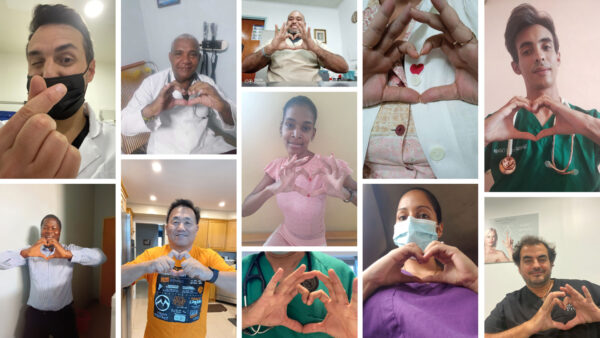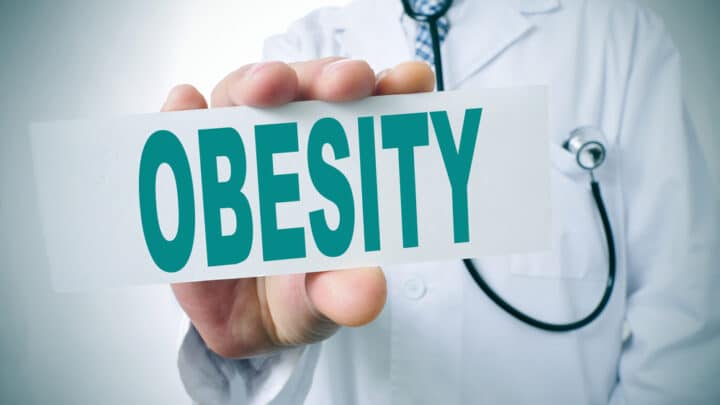
“When I started in practice 37 years ago it was very rare to have any overweight children. Now it’s the norm,” writes a pediatrician on Sermo.This statement is jarring—and an indication that something’s very wrong. 64% of physicians surveyed in a Sermo poll are very concerned with the rising rates of teenage obesity.
Once associated with high-income nations, adolescent obesity now cuts a worldwide swath across all socioeconomic levels, quietly shifting from a troubling trend to a full-blown public health crisis. What began as a slow uptick in the early 2000s–fueled by processed food, sedentary habits, and screen-heavy lifestyles–has accelerated dramatically in the aftermath of COVID-19. The pandemic didn’t just disrupt routines; it deepened isolation, heightened anxiety, and stripped away physical outlets that teens formerly relied on. In the wake of this disruption, more adolescents are entering adulthood carrying not just extra weight, but the emotional and medical burdens that come with it.
“Obesity has become one of the biggest health challenges around the world. Itʼs linked to serious conditions like heart disease, diabetes, and some cancers. Tackling it isnʼt just about personal choices—it also means improving access to healthy food, encouraging active lifestyles, and creating better public health policies,ˮ explains a UK-based psychiatrist on Sermo.
How widespread is teen obesity today?
Globally, childhood and adolescent obesity has increased dramatically: from around 4% in 1975 to nearly 20% overweight and obesity among 5-19 year-olds in 2022, totaling roughly 159 million children and adolescents worldwide with obesity. That’s quadruple the number as in 1990. According to CDC data, about one in five young people in the United States have obesity. Age, race, sex, and income all play a role, with prevalence tending to increase with age and low-income families being the most affected.
One pediatrician on Sermo adds, “Obesity is too prevalent in developed countries and very much related to lifestyle. Children eat too much processed food which is dense and nutrient-poor. Healthy eating needs to be prioritised, but sometimes processed food is cheaper than fresh! Schools can actually play a big role.ˮ
This perspective highlights how rising obesity rates are not just clinical trends, but reflections of systemic challenges, from food affordability to school-based nutrition education. For many physicians, tackling childhood obesity requires looking beyond the exam room and advocating for broader public health interventions.
What’s driving the increase?
- Screen time has surged, displacing structured physical activity.
- Emotional eating—especially post-pandemic—has become a widespread coping tool.
- Everyday movement (recess, sports, walking to school) has given way to entrenched sedentary habits.
These aren’t just lifestyle changes—they’re rewiring the metabolic trajectories of an entire generation. A Sermo poll reveals that 87% of physicians are concerned that these trends are fueling the teen obesity crisis while only 11% point to factors like genetics.
What defines obesity in teens?
Adolescent obesity is a clinical condition, not a cosmetic label. The CDC defines:
- Obesity: as BMI ≥ 95th percentile for age and sex
- Severe obesity: as a BMI ≥ 120% of the 95th percentile or a BMI ≥ 35 kg/m², whichever is lower.
These thresholds carry increased risks for several conditions, including:
- Type 2 diabetes
- Hypertension
- Coronary heart disease
- Non-alcoholic fatty liver disease (NAFLD)
- Polycystic ovary syndrome (PCOS)
- Mental illness
Alarmingly, doctors are now diagnosing these conditions in children as young as 10 to 13 years old, reshaping the scope of pediatric care worldwide. As one general practitioner on Sermo says, “Obesity is now becoming a pandemic among children and adolescents as well. It contributes to very serious health problems such as respiratory failure, early cardiovascular and cerebral accidents, and sometimes fatal thrombotic events. Prevention and the need to implement healthy lifestyle programs are very important.ˮ
The health risks of riding shotgun with adolescent obesity
Adolescent obesity isn’t just a number on a growth chart but a metabolic accelerant, pushing chronic conditions to the forefront long before adulthood. In addition to those mentioned above, here are several key health risks for teens facing obesity:
1. Insulin resistance and type 2 diabetes
Puberty naturally reduces insulin sensitivity, and when paired with excess visceral fat, adolescents can develop chronic hyperinsulinemia as early as middle school. Studies now link obesity in youth to a three-fold increase in type 2 diabetes onset—once a strictly adult diagnosis.
According to an NCBI overview, insulin resistance often precedes diabetes, and it’s becoming disturbingly common in teens, with 20% of surveyed physicians on Sermo highlighting this chronic condition as a key concern. The WHO highlights how early-onset diabetes increases lifelong disease burden and healthcare needs.
2. Fatty liver disease
Nearly 1 in 4 teens with obesity show evidence of metabolic dysfunction-associated steatotic liver disease (MASLD).
- Elevated alanine aminotransferase (ALT) and ultrasound-confirmed steatosis can progress silently into fibrosis by high school.
- MASLD is now among the most common liver diseases in youth, further complicating adolescent care.
This high prevalence and often silent nature of MASLD in teens with obesity underscores the need for increased screening and management strategies tailored to this age group, as not addressing teen metabolic health early can lead to liver failure later in life.
3. Early cardiovascular wear-and-tear
Cardiovascular disease, persistent hypertension, dyslipidemia, and arterial stiffness can begin to appear years before teens get their driver’s licenses. The WHO reports increased cardiovascular risk in obese children, with long-term complications beginning during adolescence.
Furthermore, obesity-related vascular remodeling and dysfunction in teens parallel many aspects of vascular aging observed in adults, such as endothelial dysfunction, arterial wall thickening, and impaired vasodilation. These changes suggest that obesity places adolescents at a significantly higher risk of premature cardiovascular disease due to accelerated biological aging of their arteries, comparable to around 10 extra years of vascular aging.
4. Orthopedic red flags
16% of physicians on Sermo are concerned that weight-bearing joints are taking a hit. Pediatric obesity is linked with a rising incidence of serious orthopedic conditions, such as Blount disease (tibia vara), slipped capital femoral epiphysis (SCFE), and lower-back stress fractures. These conditions are increasingly diagnosed in overweight and obese youth due to the added mechanical load and altered biomechanics on the growing skeleton.
These orthopedic complications contribute to reduced mobility, which often leads to a cycle of increased sedentary behavior, pain, social withdrawal, and further weight gain. The resulting decline in physical activity exacerbates obesity and its associated health risks, underscoring the need for early detection and intervention to break this adverse cycle. As one cardiologist on Sermo notes, “Lifestyle change is of utmost importance in the adolescence or young adults to guarantee loss of weight and lower cardiovascular risk when they are older adults. Screening for obesity in the youngest population and developing a reliable programme to effectively lose weight with or without drugs is mandatory.”
5. Mental-health concerns
About 1 of 6 physicians polled on Sermo think mental health is a key concern regarding teen obesity. Depression, social anxiety, and disordered-eating patterns rise in lockstep with BMI. Societal and peer weight shaming both in person and online multiplies the risk, often silencing teens until pathology is advanced. The stigma of mental health issues and social isolation further compound these risks, often leading to long-term psychological distress.
According to a 2023 Sermo poll, 92% of physicians believe there is a severe shortage of mental health experts who can help young people grapple with mental health issues. “Too many psychologists and not enough child psychiatrists in Australia. Mental health accounts for 70% of pediatrician visits in Australia with half of mental health issues emerging before 14 years of age.” writes a pediatrician.
One neurologist highlights an important balance in addressing mental health issues in obese teens, “…an unfair amount of blame is placed on the body positivity movement. You should love your body regardless of your size, while actively working to achieve a healthy weight for medical reasons. Fatphobia is a serious problem in our society as well”.
Research shows that obese adolescents often experience greater prevalence of emotional difficulties like depression and anxiety, in part due to poor body image, low self-esteem, and weight-based bullying or social stigma. The body positivity movement aims to counteract these harms by encouraging young people to love their bodies regardless of size, which can improve self-esteem and protect mental health even in the context of obesity.
Why teenage obesity is on the rise: A multi-factor story
Teen obesity isn’t rooted in one bad habit—it’s a tangled web of ultra-processed food, sedentary routines, screen time, limited access to fresh produce, and the lingering effects of the lockdown. In a post-pandemic study on behavioral change following COVID-19, physicians have reported spikes in HbA1c, seeing resting heart rates in the mid-80s, disrupted sleep and poor eating habits. The pandemic collapsed routines, erased sports seasons, and introduced all-day snacking coupled with anxiety and isolation—effects that haven’t fully resolved.
The reduction in PE classes, prevalence of vending machines, and changes to school meals have helped reshape the landscape of adolescent health. Teens now describe energy drinks and hot chips as a “normal breakfast,” while screen fatigue outweighs physical activity. In lower-income ZIP codes, BMI rates are almost double, and access to fresh food remains a logistical hurdle.
Biology also plays its part. Genetic predispositions, early weight gain patterns, and hormonal resistance to satiety highlight that willpower isn’t enough on its own. A 10-minute pep talk isn’t enough. Today’s physicians must navigate everything from cafeteria menus and GLP-1 prescriptions to a teen’s Twitch schedule—sometimes in one 15-minute visit.
When asked what role they thought medication plays in the treatment of teen obesity, 53% of physicians on Sermo responded that they believed medication plays a role, but only coupled with a multi-disciplinary approach to treatment. For many teens, effective weight management means rethinking every meal, moment, and message both inside and outside the clinic. According to a GP on Sermo, “…adolescent and young adult obesity is treated with a combination of lifestyle modifications, sometimes including medications or even bariatric surgery, depending on the severity and individual circumstances. Treatment typically involves a multidisciplinary approach, including nutritional guidance, increased physical activity, behavioral therapy, and in some cases, medication or surgery.”
How physicians treat teenage obesity today
For physicians today, treating adolescent obesity is less about a single prescription and more about building a sustainable, family-centered roadmap, as well as good rapport with patients and their families. The American Academy of Pediatrics (AAP) and the CDC recommend a tiered, evidence-based approach that blends lifestyle changes, behavioral support, and when appropriate, medication or surgery.
Nutrition counseling focuses on reducing ultra-processed foods, sugary beverages, and portion distortion while encouraging nutrient-dense meals packed with fiber, lean proteins, and healthy fats. It often involves meal planning, food-label literacy, and mindful eating habits to help teens develop healthier relationships with food. Registered dietitians are essential to this process, especially when adolescents have comorbidities like type 2 diabetes or MASLD.
30% of Sermo poll respondents believe processed foods have contributed to the rising rate of teenage obesity, with one family medicine physician saying, “The rates of obesity in kids and in adults is alarming, and until there are major shifts in the type and amount of food we eat, this will continue to get worse”.
Physical activity promotion centers around helping teens reach the CDC-recommended goal of 60 minutes per day of moderate-to-vigorous activity. This can take the form of structured activities like sports, dance, or even active video gaming that are tailored to individual interests, abilities, and resources. In underserved areas, physicians often rely on school and community partnerships to address limited access to safe spaces for movement and exercise.
Over a third of physicians polled in the Sermo community think a lack of physical activity is a contributing factor to the rising rate of adolescent obesity.
Family engagement is critical to sustainable outcomes, as one GP on Sermo recommends, “We have to set an example to our families to do more outdoor activities and keep us on the move. Going out with our kids when [they’re] smaller to educate in playing outside and be as active as possible and eat healthier”.
Treatment works best when the whole household commits to lifestyle changes. Family-based interventions reduce stigma and improve adherence by coaching parents to model healthy habits, create supportive food environments, and reinforce daily routines. The CDC suggests at least 26 hours of engagement over three to 12 months to achieve meaningful results.
Behavioral therapy addresses the emotional and psychological layers of teen obesity. Approaches like cognitive behavioral therapy (CBT), motivational interviewing, and personalized goal-setting help adolescents confront disordered eating patterns, social pressures, and body image struggles. Whether delivered in-person or virtually, frequent sessions can produce better outcomes and long-term change.
Challenges in sustainability and engagement
Despite strong guidelines, real-world implementation is tough:
- Access barriers: Not all families can afford or are willing to implement multidisciplinary programs.
- Stigma: Teens may avoid seeking care due to shame or fear of judgment.
- Time constraints: Physicians often lack the bandwidth for intensive counseling during routine appointments.
- Insurance gaps: Coverage for behavioral therapy and dietitian visits are inconsistent.
- Motivation dips: Adolescents may struggle with long-term commitment, especially without peer or family support.
The evolving role of medication in adolescent obesity care
Pharmacotherapy has shifted from being a fringe idea to a central part of adolescent obesity care. This surge is fueled by fast-track FDA approvals, striking efficacy data, and a demand that continues to outpace supply. GLP-1 medication for teens isn’t always widely available, so teens may begin looking elsewhere to find it for weight loss— which can be dangerous.
What’s on-label vs. off-label?
- Semaglutide (Wegovy) is FDA-approved for teens ages 12 and older to treat obesity. It shows an average BMI reduction of about 16% over 68 weeks, but access is hampered by insurance barriers and frequent back-orders.
- Liraglutide (Saxenda) is also approved for teens 12 and over, offering a 4-6% BMI reduction over 56 weeks. Its daily injection schedule can create fatigue and compliance issues.
- Tirzepatide (Zepbound) remains off-label for teens, with adult studies showing up to a 22% BMI drop. Lack of pediatric labeling keeps it in a grey area.
- Older medications like Metformin, Topiramate, and Phentermine are used off-label with modest reductions (2-5%).
The off-label Ozempic trend
Ozempic isn’t approved for adolescent obesity, yet some teens are turning to risky, unregulated channels to get it: like social media vendors, black-market sources, and borrowed prescriptions. Risks include:
- Counterfeit versions with dangerously high semaglutide levels
- Improper injection techniques causing infection or damage
- Undetected side effects like nausea or hypoglycemia
- Body image pressures leading to disordered eating and emotional distress
While drugs exist as a treatment option, many physicians on Sermo still push for them to be used as a supplementary treatment, not a one-time solution:
“Obesity meds may buy time, but they won’t fix a system that’s rigged against healthy childhoods.” – Neurology resident on Sermo
“Obesity is a very important health issue, but I don’t believe current medication has a real place, as I think it addresses the consequences rather than the cause. Medication can help in very specific extreme situations, but as of today, it is not prescribed as part of a multidisciplinary program that teaches people to change their lifestyle habits.” – Family medicine physician on Sermo
““Lifestyle changes are essential to implement in society and even more so in childhood to avoid comorbidities and pathologies in adulthood. Drugs can help in complex cases but the main tool to implement in young people is diet and exercise.” – Oncologist and Sermo member
Behind every trend line and treatment plan is a teenager trying to feel okay in their body, their mind, their life. Medication may offer new hope, but it’s not a magic fix—and it was never meant to be the full story.
Get in on the conversation
This shift in adolescent obesity care calls for something more than just medical momentum. It asks families, providers, and communities to come together with empathy, transparency, and the courage to ask hard questions. It asks us to look beyond quick outcomes and toward long-term wellbeing—physical, emotional, and relational. As one GP on Sermo puts it, “Prevention, prevention, prevention is key.”
Adolescent obesity is more than a public health issue, it’s a lived experience that demands empathy, not judgment. The science is clear, but the response must be deeper: holistic care, family engagement, and respectful conversations that prioritize hope over shame. When compassion leads the way, physicians don’t simply shift health outcomes—they rebuild trust and redefine thriving for the next generation.















